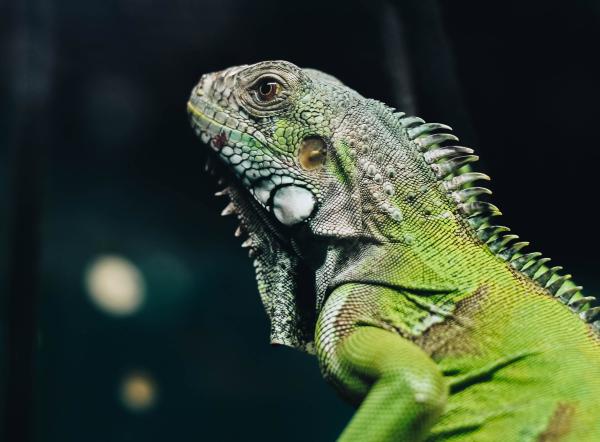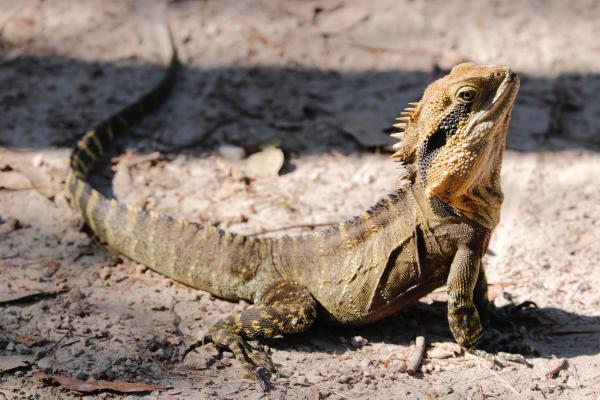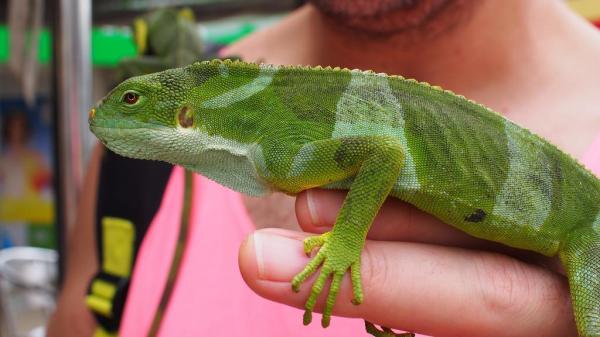
The popularity of reptiles as pets has increased exponentially worldwide. Among them, the green iguana stands out as one of the favorites due to its exceptional beauty and elegant appearance. As a result of keeping and breeding in captivity, this beautiful animal has developed a variety of health problems that can be aggravated by people who do not know how to provide the basic care that this species requires.
The following AnimalWised article explains the most common diseases in iguanas, so you know what to look for and when to seek treatment.
Common diseases of the green iguana
As with any other animal species, including humans, proper nutrition is the basis for disease prevention. And the iguana is no exception! Reptiles in captivity need a proper diet that allows them to grow well and strengthens their immune system. When iguanas live in a suitable environment, are well-fed and exposed to UV light, they are quite hardy animals.
All body systems of iguanas can be affected by disease: Respiratory, reproductive, and gastrointestinal. Below, we will take a closer look at some of the most common problems.
If you want to learn more about how to feed your iguana properly, do not miss this other article, where we describe everything you need to know about green Iguana diet.
Metabolic bone disease in iguanas
Metabolic bone disease is one of the most common health problems in captive green iguanas. The main causes of this pathology are the result of improper handling by human caretakers.
This common disease in iguanas is mainly caused by:
- Improper diet: A diet poor in calcium and vitamin D3 leads to an incorrect ratio of calcium and phosphorus.
- Inadequate exposure to ultraviolet B light: The absence of ultraviolet B type light, both natural and artificial, favors the development of this pathology.
The most common clinical signs of this condition are:
- Soft and deformed jaw
- Spontaneous fractures
- Deformed bones and spine
To avoid this issue, you must ensure that your iguana receives a balanced diet based on green leaves. As for ultraviolet B light, you should offer the animal direct sunlight whenever you have the opportunity. If this is not possible, you should place the terrarium in an artificial ultraviolet B light spectrum and offer the iguana a period of 12 hours of light and 12 hours of darkness. During light exposure, regardless of the light source, you must ensure that there are no plastics or crystals between the light beam and the animal, otherwise the ultraviolet radiation will be absorbed by them and not by the animal.

Parasites in iguanas
Plants and stems used in terrariums to enrich the iguana's environment and simulate its natural habitat sometimes bring some external parasites.
Ticks, for example, are easily visible and can be removed by pulling firmly until they dislodge, then treating the bite site with a topical antibiotic such as Neosporin.
Mites are a little more difficult to control because they reproduce extremely quickly. The most common are the parasites of the genus Hirstiella, usually visible to the naked eye as red dots on the skin of the animal.
When an iguana is infested with mites, the lizard will bathe in its water bowl for extended periods of time to rid itself of the pests. To successfully control a mite infestation, you must treat your pet and thoroughly clean its cage and furnishings. You should also visit your veterinarian so that they can diagnose the problem and initiate appropriate treatment.
Other common parasites in iguanas are internal parasites. Internal parasites include nematodes, pinworms, hookworms, cestodes, coccidia and protozoa. Internal parasites interfere with food processing and absorption of nutrients, cause discomfort and damage the gastrointestinal tract.
If you visit your veterinarian regularly, they will examine your iguana's feces under a microscope and rule out the presence of parasites or, if they detect any, administer an appropriate dewormer.

Abscesses in iguanas
An abscess is an infected swelling filled with pus. Abscesses are another of the most common health problems in iguanas, especially those that live in groups and attack each other for territorial reasons. These abscesses are commonly a result of trauma, bite wounds, invasions by foreign bodies, tumors, or parasites, bacteria (most common) or fungi invade tissues. Subcutaneous abscesses are also common. Abscesses in the oral cavity cause visible swelling on the upper or lower jaw and may cause difficulty eating.
Abscesses are diagnosed by appearance, palpation, fine needle aspiration, or surgical exploration. They are treated by surgical excision or cutting open and irrigation of the abscess. Treating an abscess requires the veterinarian to prescribe an antibiotic. In the most severe cases, surgery may even be required. So, if you notice swelling in your iguana, see a veterinarian as soon as possible! Never attempt to drain an abscess yourself, as the wound may become contaminated or infected, or may not heal properly.

Reproductive problems in iguanas
One of the most common reproductive problems in captive female iguanas is dystocia. This is when the eggs become trapped in the oviduct and the iguana is unable to expel them.
The main causes of this common condition in iguanas are:
- Lack of a suitable place to lay
- Too hard substrate
- Lack of exposure to sunlight
- Unsuitable diet
- Stress
- Females that are too young or too old
- Problems with the eggs, such as broken eggs, higher number than usual, etc.
Like most other problems, this one is also caused by inadequate care from the caregivers. If you provide your iguana with the right conditions and go to the vet regularly, it will be more difficult for any problems to occur. However, as you can see from the list of causes, there are also some internal reasons that cannot be controlled. For this reason, it is important to pay attention to these clinical signs:
- Swollen abdomen
- Anorexia
- Increased frequency of urination
- Behavior changes, such as the iguana's constant search for nesting sites
If you suspect your iguana has this issue, see a veterinarian immediately. Treatment usually consists of administering calcium and oxytocin. In more severe cases with constipation, surgery may be required.
Behavioral problems in iguanas
All iguanas have different personalities. Some become tame and calm, others remain aggressive. To become calm, the iguana must be tamed and trained.
Behavioral problems are one of the main reasons for abandoning these animals. Male iguanas in particular may exhibit more aggressive behavior during puberty for territorial reasons.
Some veterinarians suggest neutering to reduce aggressive problems. However, it is important to accept that this is a natural behavior of this species and can be avoided in most cases if adequate space and an enriching environment are provided.
If you want to pick up your iguana, always handle them from underneath, as if your arm were a tree trunk, so they can hold onto you. Never lift them up, because the iguana may feel threatened and as a result show aggressive behavior out of fear.

How to know if my iguana is sick?
Even if everything seems normal, your iguana may be suffering from a health problem. This is why regular visits to the veterinarian are so important. These changes may not be visible to our eyes, but a professional pet expert will not miss them. If you have an iguana as a pet, you may sometimes find it a little difficult to interpret its moods. After all, iguanas are not the most expressive animals. Iguanas tend to hide signs of illness for as long as possible. This is a defense trick they learned in the wild. Reptiles in general are very resilient animals, and sometimes it is hard to tell that something is wrong, and by the time we notice it is already too late.
The best way to find out if the iguana is sick is to carefully observe them every day and pay attention to their behavior and physical condition. If for some reason their behavior changes, they stop eating, drinking, urinating or having bowel movements, you should know that these are the first symptoms that indicate that something is wrong. Other symptoms may include:
- Loss of appetite
- Lack of energy
- Twitching
- Loss of balance
- Vomiting
Home care, proper diet, and visits to the veterinarian are key to preventing the most common diseases in iguanas. So do not hesitate to invest in prevention.

This article is purely informative. AnimalWised does not have the authority to prescribe any veterinary treatment or create a diagnosis. We invite you to take your pet to the veterinarian if they are suffering from any condition or pain.
If you want to read similar articles to Most Common Diseases in Green Iguanas, we recommend you visit our Other health problems category.
- Silvestre, AM (2003) Diseases of reptiles . reptilian editions
- Mader, D. M. Reptile Medicine and Surgery . Elsevier. 2nd Edition